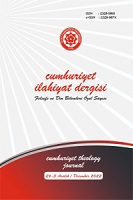Malezya ve Türkiye’de Devlet Üniversitelerinde Yüksek Din Öğretimi: Karşılaştırmalı Bir Çalışma
Higher Religious Education at Public Universities in Malaysia and Turkey: A Comparative Study
Author(s): Abdurrahman Hendek, Asyraf İsyraqi JAMİL, Mahmut Zengin, Mohamad Khairi BİN OTHMANSubject(s): Islam studies, Higher Education , State/Government and Education, Sociology of the arts, business, education, Sociology of Education, Sociology of Religion
Published by: Cumhuriyet Üniversitesi İlahyat Fakültesi
Keywords: Religious Education; Religious Studies; Higher Education; Malaysia; Turkey;
Summary/Abstract: Higher religious education institutions, like other fields, operate within the universities today. While countries establish and develop their own institutions according to their history, society and state, the experience and knowledge of similar institutions in other countries is vital for the development of the universities. Comparative studies can make significant contributions in this regard. Therefore, this article aims to compare higher religious education at public universities in Malaysia and Turkey in terms of six themes: history, current situation, aims, programme structure, student admission and graduate employability. Malaysia and Turkey represent two strikingly different countries in terms of the state’s relationship with religion and the religious composition of society even though they both have a Muslim majority population. This is a qualitative, literature-based study which employs document analysis. Official documents, academic articles and internet sources are used as references to examine and present information about higher religious education in both countries. The findings of the article are as follows: The development of higher religious education in Turkey has been intermittent and is closely related to the politics of religion, as the major political changes have had an impact on higher religious education. In contrast, the development of higher religious education has been steadier in Malaysia. Even though the politics of religion and electoral calculations of political parties have influenced higher Islamic education in Malaysia, this has not at least resulted in their closures or dramatic decreases in their numbers. Currently, higher religious education is thriving in both countries, but more rapidly (at least quantitively) in Turkey than in Malaysia. Regarding the aims of higher religious education, there are direct references to Ahl al-Sunnah wa al-Jama‘ah and raising practising Muslims in Malaysia, where the aims and programme outcomes are determined by a national agency. Historically, the official mission statements of theology faculties in Turkey were more inclined towards modern aims/concepts, partly to legitimise the place of theology in a secular university. However, in recent years, there has been a tendency towards overtly Islamic values and concepts. However, due to the lack of a national agency which defines the aims of theology/Islamic sciences faculties, the official mission and vision statements seem patchy and vague, but the accreditation process might lead to more common and unified aims and programme outcomes. In Turkey, higher religious education officially does not adopt any branch of Islam, as opposed to Malaysia, which might be an opportunity for becoming more accommodative and integrative in a modern society which is marked by plurality and diversity. There are different higher religious education programmes in Malaysia, which has sought to integrate Islamic knowledge with professional one. This has resulted in the introduction of multi and cross-disciplinary programmes and specializations. The graduates of these programmes, in turn, can work in very different professions from security to finance and from judiciary to religious services. Multi and cross-disciplinary programmes are currently unavailable in Turkey, as higher religious education faculties only offer a single programme. Another important difference between the two countries is the process of student admission. While there are different post-secondary education/examination systems in Malaysia, in Turkey there is a national university entrance exam. Despite the different examination systems, in Malaysia students need to have a solid background in Islamic education, Arabic and English in order to enrol on Islamic Studies programmes; whereas in Turkey there are just few questions regarding religious education in the university entrance exam; therefore, no background in religious education, Arabic or English is necessary. Even though this can provide an opportunity for those who do not have any Islamic education background, there are problems that theology/Islamic sciences faculties have to start from the basics, such as teaching how to read the Qur’an. Finally, in both countries the employability of higher religious education graduates seems one of the most pressing issues, but this issue is more prevalent in Turkey than in Malaysia.
Journal: Cumhuriyet İlahiyat Dergisi
- Issue Year: 26/2022
- Issue No: 3
- Page Range: 987-1002
- Page Count: 16
- Language: Turkish

